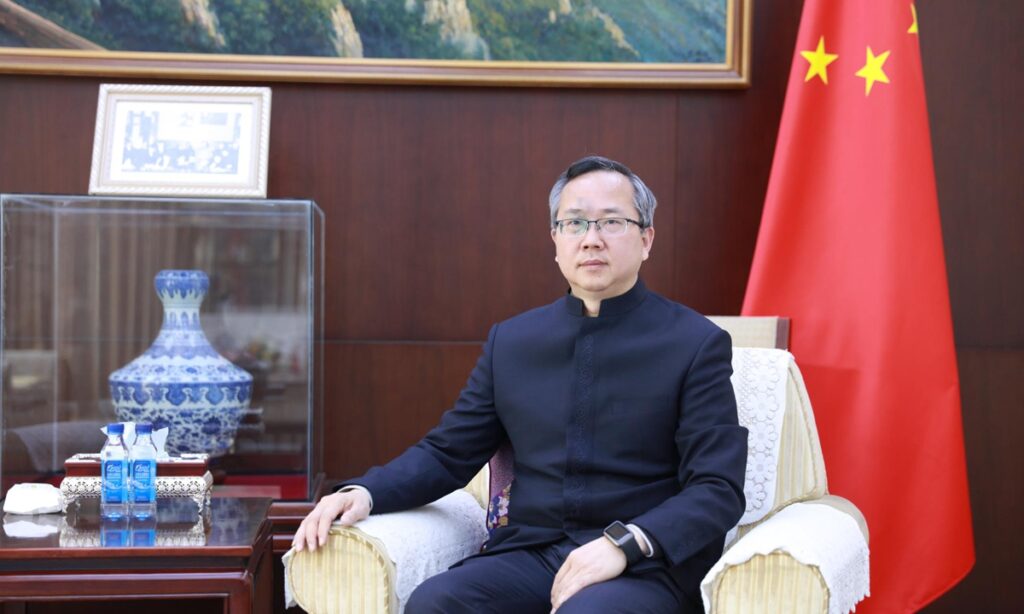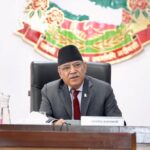On September 26, China and Nepal issued a joint statement during Nepali Prime Minister (PM) Pushpa Kamal Dahal Prachanda’s visit to China, agreeing to pursue high-quality BRI cooperation. Both countries expressed a readiness to deepen practical cooperation in such fields as infrastructure connectivity, trade, tourism, production capacity and investment, and further deepen and solidify Belt and Road cooperation to deliver greater benefits to their peoples. Following the visit of Nepali PM to China, the Global Times reporter Chu Daye (GT) interviewed Chen Song (Chen), Chinese Ambassador to Nepal, discussing the recovery of bilateral trade and economic tie in the post-pandemic period and the highlights of next-stage cooperation.
GT: In the post-pandemic period, to what extent had China-Nepal trade, travel and people-to-people exchanges recovered? What are the future highlights of China-Nepal trade and economic cooperation?
Chen: Since January, China-Nepal cooperation in various aspects has shaken off the impacts of the COVID-19 pandemic. In trade, Nepal’s exports to China in the first eight months of this year has surged up by 118.3 percent over the same period in 2022. Nepal for the first time exported haylage to China. The ports at Jilong, Zhangmu, and Pulan resumed dual-way passenger and cargo traffic. The first shipment of goods arrived in Nepal via China. For people-to-people exchanges, direct flights have largely recovered to pre-pandemic level, and the number of Chinese visitors to Nepal has reached 32,000 by end of August. In fact, China was the second ranked source of tourist arrivals for Nepal in August. Next, I believe that China-Nepal trade and economic cooperation will see faster implementation in the construction of Trans-Himalayan Multi-Dimensional Connectivity Network, and deepened cooperation in energy, agriculture, animal husbandry and industrial parks. China is willing to support Nepal to push forward agricultural modernization, energy autonomy, industrial upgrading and transformation; help Nepal ease its international balance of payments, accelerate economic development, improve people’s livelihood and better safeguard its independence.
GT: What is the significance of the Nepali PM’s visit to China?
Chen: The Chinese side attached great importance to China-Nepal ties, this could be seen from the series of meetings by Chinese leaders with the visiting Nepali PM. The Nepali side reiterated that Tibet affairs are China’s own internal affairs, that it will never allow any separatist activities against China on Nepal’s soil. The two sides’ consensus to expand the scope of pragmatic cooperation and nurture new growth points in agriculture, industrial capacity and digital economy could allow Nepal to be better integrated into China’s new development pattern and benefit from Chinese modernization.
GT: China and Nepal have agreed to further cooperation on cross-border electricity trading and agriculture. What progress has been made and how do you see the potential of this area?
Chen: During the visit, the two sides agreed to further promote cooperation in the field of energy, particularly the development of hydropower and cross-border transmission lines and associated substations. Both parties agreed to launch the construction of the Jilong/Keyrung-Rasuwagadhi-Chilime 220 KV Cross-Border Power Transmission line at an early date. Such deals will provide Nepal with a more secure and reliable channel for electricity imports and exports. China will deepen electricity cooperation with Nepal, enhance connectivity of the grid network and increase the value added of Nepal’s hydro power, and make it a truly powerful engine of economic growth for Nepal.
For agriculture, there has been some progress made by transferring Chinese agricultural technology to Nepal. I can say that in the next phase, China is willing to explore the idea of setting up a pilot area of agricultural cooperation, assist Nepal’s efforts to modernize its agriculture, and is happy to see such efforts could help improve Nepalese people’s livelihood and reduce poverty. This shall happen at the same time together with Chinese efforts to help Nepal to sell its agricultural products into China. China already offers zero-tariff treatment for 98 percent of Nepali exports to China.
GT: What is the latest progress for the China-Nepal railway?
Chen: It should be said that building the China-Nepal railway is the common aspiration of the leaders and peoples from the two countries. The railway comprises the Chinese section and the Nepali section and now both sides were accelerating efforts to promote the project. Xizang Autonomous Region is steadfastly promoting the Xigaze-Jilong section of the railway according to its 14th Five-Year Plan (2021-25), which includes planning and building of a stretch of railway at Jilong Port. Late last year, a panel of railway experts for the China-Nepal railway conducted a feasibility study. This provides a solid foundation for further work to proceed. The China-Nepal Railway is a core component of the Trans-Himalayan Multi-Dimensional Connectivity Network. It will help Nepal realize its dream of reinventing itself into a land-linked country from a land-locked country. Related projects will constantly enhance the autogenic capacity of Nepal’s economy and give wings to Nepal’s development.
GT: This year marks the 10th anniversary of the BRI, what achievement has been made by China and Nepal under the BRI framework?
Chen: Since China and Nepal inked a memorandum of understanding on Belt and Road cooperation in 2017, a series of fruitful results has been achieved. There was more policy alignment, improved exchange mechanisms for trade and economic issues, and streamlined connectivity programs that formed up a web of multi-dimensional connectivity network in such areas as ports, roads, railways, airways and telecommunications. Trade at border ports have been facilitated to recover to pre-pandemic level. The Chinese side support Nepali side to participate in major platforms such as the China International Import Expo, China-South Asia Expo and Xizang Tourism and Culture Expo to facilitate the export of Nepali products to China. WeChat payment’s functioning in Nepal this year further facilitated Chinese tourists and cross-border trade. There will also be more direct international flights and expanded medical aid to Nepal and cooperation in providing healthcare and medical services.
GT: Some in the West have labeled China’s investment in developing countries such as Nepal as a debt trap, how do you respond to such a claim?
Chen: China’s development is an opportunity rather than a challenge or a threat to the world. During the past decade, China’s cooperation with developing countries including Nepal has adhered to the principle of extensive consultation, joint contribution and shared benefits and were carried out with respects to the wishes of relevant countries. China has never forced any country to take loans, has never pressed debt from any country, nor attached any political conditions to the loan agreement. The so-called “debt trap” claim is a narrative trap created by forces who do not want to see the accelerating momentum of growth by developing countries. On the debt issue, developing countries know best from their own experience who is a sincere and reliable friend and who is a rumor-monger with ulterior motives. This is also quite clear to people with insights across the world.
(Global Times)




